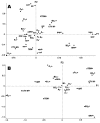Genetic background of Escherichia coli and extended-spectrum beta-lactamase type
- PMID: 15705323
- PMCID: PMC3294364
- DOI: 10.3201/eid1101.040257
Genetic background of Escherichia coli and extended-spectrum beta-lactamase type
Abstract
To assess the implication of the genetic background of Escherichia coli strains in the emergence of extended-spectrum-Beta -lactamases (ESBL), 55 TEM-, 52 CTX-M-, and 22 SHV-type ESBL-producing clinical isolates involved in various extraintestinal infections or colonization were studied in terms of phylogenetic group, virulence factor (VF) content (pap, sfa/foc, hly, and aer genes), and fluoroquinolone resistance. A factorial analysis of correspondence showed that SHV type, and to a lesser extent TEM type, were preferentially observed in B2 phylogenetic group strains that exhibited numerous VFs but were fluoroquinolone-susceptible, whereas the newly emerged CTX-M type was associated with the D phylogenetic group strains that lacked VF but were fluoroquinolone-resistant. Thus, the emergence of ESBL-producing E. coli seems to be the result of complex interactions between the type of ESBL, genetic background of the strain, and selective pressures in ecologic niches.
Figures

Similar articles
-
Characteristics of Romanian fluoroquinolone-resistant human clinical Escherichia coli isolates.Roum Arch Microbiol Immunol. 2008 Jan-Jun;67(1-2):23-9. Roum Arch Microbiol Immunol. 2008. PMID: 19284163
-
National survey of Escherichia coli causing extraintestinal infections reveals the spread of drug-resistant clonal groups O25b:H4-B2-ST131, O15:H1-D-ST393 and CGA-D-ST69 with high virulence gene content in Spain.J Antimicrob Chemother. 2011 Sep;66(9):2011-21. doi: 10.1093/jac/dkr235. Epub 2011 Jun 13. J Antimicrob Chemother. 2011. PMID: 21669946
-
ESBL-producing Escherichia coli isolated from children with acute diarrhea - antimicrobial susceptibility, adherence patterns and phylogenetic background.Adv Clin Exp Med. 2012 Mar-Apr;21(2):187-92. Adv Clin Exp Med. 2012. PMID: 23214282
-
Genetic evolution and clinical impact in extended-spectrum β-lactamase-producing Escherichia coli and Klebsiella pneumoniae.Infect Genet Evol. 2011 Oct;11(7):1499-504. doi: 10.1016/j.meegid.2011.06.001. Epub 2011 Jun 12. Infect Genet Evol. 2011. PMID: 21689785 Review.
-
Extraintestinal pathogenic Escherichia coli: an update on antimicrobial resistance, laboratory diagnosis and treatment.Expert Rev Anti Infect Ther. 2012 Oct;10(10):1165-76. doi: 10.1586/eri.12.110. Expert Rev Anti Infect Ther. 2012. PMID: 23199402 Review.
Cited by
-
CRISPR distribution within the Escherichia coli species is not suggestive of immunity-associated diversifying selection.J Bacteriol. 2011 May;193(10):2460-7. doi: 10.1128/JB.01307-10. Epub 2011 Mar 18. J Bacteriol. 2011. PMID: 21421763 Free PMC article.
-
The Arginine Deiminase Operon Is Responsible for a Fitness Trade-Off in Extended-Spectrum-β-Lactamase-Producing Strains of Escherichia coli.Antimicrob Agents Chemother. 2019 Jul 25;63(8):e00635-19. doi: 10.1128/AAC.00635-19. Print 2019 Aug. Antimicrob Agents Chemother. 2019. PMID: 31138573 Free PMC article.
-
Phylum barrier and Escherichia coli intra-species phylogeny drive the acquisition of antibiotic-resistance genes.Microb Genom. 2021 Aug;7(8):000489. doi: 10.1099/mgen.0.000489. Microb Genom. 2021. PMID: 34435947 Free PMC article.
-
Phylogenetic grouping and virulence potential of extended-spectrum-β-lactamase-producing Escherichia coli strains in cattle.Appl Environ Microbiol. 2012 Jul;78(13):4677-82. doi: 10.1128/AEM.00351-12. Epub 2012 Apr 20. Appl Environ Microbiol. 2012. PMID: 22522692 Free PMC article.
-
In vitro antibacterial activity of ZnO and Nd doped ZnO nanoparticles against ESBL producing Escherichia coli and Klebsiella pneumoniae.Sci Rep. 2016 Apr 13;6:24312. doi: 10.1038/srep24312. Sci Rep. 2016. PMID: 27071382 Free PMC article.
References
-
- Saladin M, Cao VT, Lambert T, Donay JL, Herrmann JL, Ould Hocine Z, et al. Diversity of CTX-M β-lactamases and their promoter regions from Enterobacteriaceae isolated in three Parisian hospitals. FEMS Microbiol Lett. 2002;209:161–8. - PubMed
Publication types
MeSH terms
Substances
LinkOut - more resources
Full Text Sources
Medical
Research Materials
